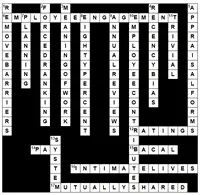The Vague Meaning Of Workplace Bullying
It's very easy to develop a belief that bullying can be defined easily, clearly, and in some objective ways. And theoretically you could do that. You could, for example, include in a definition of bullying, the use of swear words.Or perhaps you could include specific examples of teasing, or insulting. Or, how about these, defined by Hoel and Cooper: (Destructive Conflict and Bullying at Work, Sponsored by the British Occupational Health Research Foundation, Manchester School of Management, UMIST
- Having opinions and views ignored
- Withholding information which affects the target's performance
- Being exposed to an unmanageable workload
- Being given tasks with unreasonable or impossible targets or deadlines
- Being ordered to do work below competence
- Being ignored or facing hostility when the target approaches
- Being humiliated or ridiculed in connection with work
- Excessive monitoring of a person's work (see micromanagement)
- Spreading gossip
- Insulting or offensive remarks made about the target's person (i.e. habits and background), attitudes or private life
- Having key areas of responsibility removed or replaced with more trivial or unpleasant tasks
There's a serious problem with all of these elements when they are used to define bullying. They don't refer to specific behaviors per se, and they often occur in a workplace where there is no mal intent, or efforts to bully an employee. One could easily imagine an employee experiencing some of these elements in the natural course of job evolution -- for example, having key areas of responsibility removed, or exposed to an unmanageable workload. These things happen so incredibly often, and without bad intent, that they become hard to use to discriminate between true bullying that should be actionable, and just common occurences.
Beyond that, if you look at these criteria, it should jump out at you immediately that while it seems they are clear, in fact, they are not, because there's no way of defining HOW MUCH of any of these constitutes malicious behavior. For example, excessing monitoring of person's work (4). What is excessive? In fact, how can anyone, in investigating a charge of workplace bullying, have any hope of determining what that could possibly mean, given management's perogative, and even obligation to monitor performance, if only to HELP an employee succeed?
An Additional Issue: Context Is Everything When It Comes To Workplace Bullying
There's an even bigger impediment to coming to a tight definition of workplace bullying so that it yields clear guidelines to employees about what is and is not acceptable. As is the case with sexual harrassment, the perceptions of the "recipient" are critical, as is the context of the relationship between two people. A behavior, let's say teasing, can be a sign of affection in a relationship where two people are constantly teasing each other. Or, in a different relationship, that same behavior, the exact same words, even, can be perceived as, and in fact could be bullying.
You can't simply look at most behaviors and say: "Ah. That's bullying", without taking into account the relationship, and even the culture of the organization. So, in fact, strict behavioral definitions don't capture the context, the interpretations that the recipient creates about the "bullying behavior". Is that "playful smack on the arm" a sign of affection? Or in fact, the action of a bully? Or, is the insult directed at a co-worker simply a reflection of how two people habitually interact, or, is it in fact part of a pattern of verbal abuse that can be part of the bullying pattern.
What Are The Implications
First, this is the reality. One cannot define bullying in absolute tight and observable ways. One has to look at several other factors that are non-behavioral to determine if there is a bullying relationship going on. And of course, the more we move from observable behaviors as indicators, the more we introduce subjectivity into the equation. So, we have to infer intent, since intent exists only in the mind of the person enacting the behavior. We have to make some assumptions about what's "reasonable" in a work relationship. It would not, for example, be reasonable to dangle someone out a seven story window, "as a joke", no matter what the relationship between the two parties. So, there can be clear limits. But most bullying or alleged bullying is in those gray areas. So, you have to look at issues like persistance, frequency, how a person treats not only the supposed target, but also others to see if there's consistency or not.
And finally, of course, you need to look at the effects of the behavior on the target. And that gets even more challenging. Sensitivities differ. Some accusations of being bullied are unreasonable allegations. Yet, reasonable or not, the effects on the target are the same.
Given the challenges of defining in objective terms, what bullying entails, it's still not justified to throw up our hands. Not everything is cut and dried. Companies can't shirk their responsibilities to create a safe, productive environment in which to work, but it's important to understand the challenges in defining bullying if companies are to succeed in reducing it, which, after all, is a goal we can all embrace.




